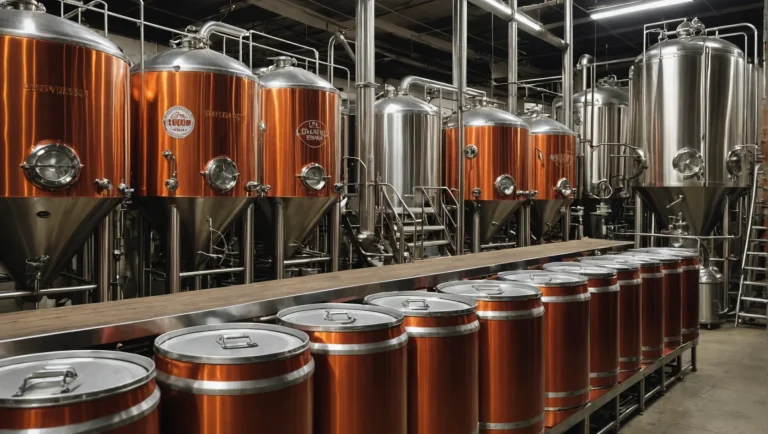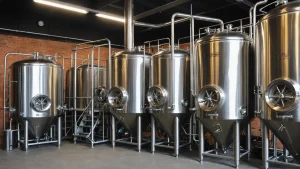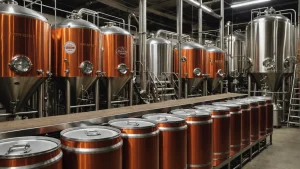Are you a business owner dreaming of turning your passion for craft beer into a thriving brewery?
Brewing success takes more than just a great recipe – you need a solid business plan to guide your way.
In this comprehensive guide, we’ll walk you through the essential components of a winning brewery business plan for 2024 and beyond.
From defining your unique value proposition to securing financing and building a strong brand, we’ve got you covered.
Breweries In The U.S.
As of December 2023, there were 14,597 total approved breweries in the U.S. by the U.S. Tax and Trade Bureau (TTB)

Save 80% of delivery management time
We handle everything:
- Dedicated operations manager
- Real-time tracking dashboard
- Automated customer notifications
- Urgent issue resolution
Brewery Business Plan Essentials: Key Components for Success
Defining Your Brewery’s Unique Value Proposition
To create a successful brewery, you need to understand your target market. Conduct thorough market research to identify the demographics, preferences, and behaviors of your potential customers. You should consider factors such as age, income, location, and beer preferences. Once you have a clear picture of your target market, determine what sets your brewery apart from competitors. This could be your unique brewing process, signature beer styles, taproom experience, or commitment to sustainability.
TIP- Research local and regional competition to ensure your unique value proposition truly sets you apart.
Develop a clear mission statement and brand identity
Your mission statement should encapsulate the purpose and values of your brewery. It should be concise, memorable, and reflective of your unique value proposition. You can use this mission statement to guide your brand identity, including your logo, color scheme, and messaging. Ensure that your brand identity resonates with your target market and effectively communicates your brewery’s personality and values.
Outline your brewery’s core values and goals
Establish a set of core values that will guide your brewery’s operations and decision-making. These values should align with your brewery unique mission statement and brand identity. Examples of core values could include a commitment to quality, innovation, community involvement, and environmental responsibility. Additionally, you should set clear, measurable goals for your brewery’s growth and success. These goals should be specific, achievable, and aligned with your overall mission. For resources on setting these goals and establishing core values, explore beer-making business plan templates and examples that can help kickstart your brewery’s strategy with both free and premium options available.
Creating a Detailed Financial Plan
Estimate startup costs, including equipment, facilities, and inventory
To create a realistic financial plan, you must first estimate your startup costs. This includes the cost of brewing equipment, such as fermentation tanks, kegs, and bottling or canning lines. Also, factor in the cost of leasing or purchasing a facility, as well as any necessary renovations or build-outs. You shouldn’t forget to account for the initial inventory of ingredients, packaging materials, and merchandise.
Project revenue and expenses for the first 3-5 years
Develop detailed financial projections for the first 3-5 years of operation. Estimate your revenue based on production capacity, distribution channels, and pricing strategy. Be sure to account for various revenue streams, such as taproom sales, wholesale distribution, and merchandise. On the expense side, you can consider the ongoing costs of ingredients, labor, utilities, marketing, and loan payments (if applicable).
Determine pricing strategy and profit margins
Establish a pricing strategy that aligns with your target market and financial goals. You can consider factors such as production costs, competitor pricing, and the perceived value of your products. You should aim for profit margins that allow for sustainable growth and reinvestment in your brewery. Regularly review and adjust your pricing strategy as market conditions change and your brewery evolves. Interested in maintaining a lucrative brewing business? Regularly re-evaluate your strategy to ensure your pricing aligns with a profitable brewery’s benchmarks.
Develop a break-even analysis
Conduct a break-even analysis to determine the point at which your brewery will become profitable. This analysis takes into account your fixed costs (such as rent and equipment payments) and variable costs (such as ingredients and packaging) about your revenue. You can use this information to set sales targets and make informed decisions about production levels and expansion plans.
Outlining Your Brewery’s Operational Structure
Define roles and responsibilities for key team members
As you develop your brewery’s operational structure, clearly define the roles and responsibilities of each key team member. This includes positions such as head brewer, taproom manager, sales manager, and finance manager. Create detailed job descriptions that outline the expected duties, qualifications, and reporting structure for each role. Ensure that all team members understand their responsibilities and how they contribute to the overall success of the brewery.
Establish standard operating procedures for production and quality control
To ensure consistent quality and efficiency, establish standard operating procedures (SOPs) for all aspects of your brewing process. This includes procedures for ingredient handling, brewing, fermentation, packaging, and cleaning. You can develop a quality control plan that outlines the steps for monitoring and maintaining the quality of your beer at each stage of production. Regularly you should train your team on these SOPs and conduct audits to ensure compliance.
Plan for inventory management and distribution channels
Effective inventory management is crucial for minimizing waste and ensuring a steady supply of ingredients and finished products. Develop a system for tracking inventory levels, ordering supplies, and rotating stock. Consider investing in inventory management software to streamline this process. Additionally, you should plan for your distribution channels, whether that includes self-distribution, working with a distributor, or a combination of both. Establish relationships with key partners and create a distribution plan that aligns with your production capacity and market demand. Metrobi specializes in facilitating delivery services across more than 20 cities in the US, including offering courier services in Los Angeles, to assist beverage businesses in enhancing their distribution efforts.
By thoroughly addressing these key components in your brewery business plan, you’ll create business plan template and a strong foundation for securing funding and launching a successful venture. In the following section, we’ll explore strategies for financing your brewery startup and securing the capital needed to bring your vision to life.
Brewery Statistics
In 2023, there were 7,752 reporting brewery facilities/locations in the U.S., which is less than half of the total approved breweries

Metrobi is transforming beverage deliveries
Specialized solutions for beverage businesses:
- Beverage-trained drivers
- Proper handling equipment
- Peak day delivery support
- 23% average cost reduction
Financing Your Brewery Startup: Securing Capital
Exploring Traditional Financing Options
When starting a brewery, one of the first options to consider is traditional financing through banks and credit unions. These institutions offer various loan products tailored to small businesses, including term loans, lines of credit, and equipment financing. Researching and comparing rates, terms, and eligibility requirements from multiple lenders can help you find the most suitable option for your brewery. At Metrobi, we specialize in assisting beverage companies with their delivery operations, offering tailored solutions for the logistics of beverages.
Another avenue to explore is Small Business Administration (SBA) backed loans. The SBA partners with lenders to provide loans with more favorable terms and lower down payments compared to traditional bank loans. Programs like the SBA 7(a) loan and the SBA 504 loan can be particularly helpful for breweries looking to purchase real estate or equipment. At Metrobi, we specialize in offering delivery services across more than 20 cities in the US, including providing same-day delivery options in Philadelphia.
Additionally, you should investigate local and state grants specifically designed for breweries or small businesses in your area. These grants may have specific requirements, such as job creation or community development, but can provide valuable funding without the need for repayment.
Attracting Investors and Equity Financing
For breweries seeking more substantial funding, attracting investors and offering equity in your company can be a viable option. To entice potential investors, develop a compelling pitch deck that showcases your brewery’s unique selling proposition, target market, financial projections, and growth potential. Highlight the experience and expertise of your team, as well as any traction you’ve already gained, such as contracts with distributors or a loyal customer base.
Networking plays a crucial role in finding the right investors for your brewery. Attend industry events, join local business associations, and connect with successful brewery owners who may have insights into potential investment opportunities. Online platforms like AngelList and Crunchbase can also help you connect with accredited investors interested in the craft beer industry.
When considering equity financing, it’s essential to understand the implications of giving up a portion of your company’s ownership. To ensure clarity and legal protection, using a loan agreement template can help formalize any loan arrangements with investors, outlining the terms of repayment and safeguarding your interests. You should work with a legal professional to structure equity agreements that align with your long-term business goals, and protect your interests as the brewery’s founder.
Crowdfunding and Alternative Financing Methods
In recent years, crowdfunding has emerged as a popular way for breweries to raise capital and build a loyal customer base simultaneously. Platforms like Kickstarter and Indiegogo allow you to create campaigns where supporters can contribute funds in exchange for rewards, such as exclusive merchandise, early access to new beer releases, or even equity in your company (via equity crowdfunding platforms like Wefunder or StartEngine).
To run a successful crowdfunding campaign, you should create a compelling story around your brewery’s mission and the values, and offer enticing rewards that encourage supporters to contribute. Leverage your social media presence and email list to promote the campaign and keep backers engaged with regular updates on your progress.
Another alternative financing method is to offer pre-sales or memberships to generate early revenue. By selling advance tickets to events, offering subscriptions for regular beer deliveries, or creating a membership program with exclusive perks, you can secure funding from your most loyal customers while fostering a sense of community around your brand.
Lastly, consider equipment leasing as a way to reduce upfront costs associated with purchasing brewing equipment. Leasing allows you to spread out payments over time and can offer more flexibility compared to traditional loans. Be sure to compare leasing terms from multiple providers and factor in any additional costs, such as maintenance and insurance, when making your decision.
The average profit margin for breweries in the US is approximately 15.6%. By exploring a mix of traditional and alternative financing options, you can secure the capital needed to bring your brewery vision to life. Remember to thoroughly research and compare each method’s terms, interest rates, and repayment structures to ensure you choose the best fit for your business’s needs and goals.
Crafting a Brewery Marketing Strategy: Building Your Brand
Developing a Strong Brand Identity
Creating a strong brand identity is crucial for a brewery to stand out in a crowded market. Your brand identity should encompass a memorable logo, consistent visual elements, and a unique brand story that resonates with your target audience.
Creating a Memorable Logo and Visual Elements
Your logo is the face of your brewery and should be easily recognizable, memorable, and reflective of your brand’s personality. Consider working with a professional designer to create a logo that captures the essence of your brewery. Ensure that your logo is versatile and can be used across various marketing materials, such as packaging, merchandise, and digital platforms.
In addition to your logo, establish a consistent color palette, typography, and imagery that aligns with your brand’s personality. These visual elements should be used consistently across all marketing channels to create a cohesive brand experience for your customers.
Establishing a Consistent Tone and Voice
Your brand’s tone and voice should be consistent across all marketing channels, from your website and social media to your packaging and customer interactions. Determine the personality traits that best represent your brewery, such as friendly, approachable, or sophisticated, and ensure that your messaging aligns with these traits.
TIP- Consider creating a brand style guide that outlines your brand’s tone, voice, and messaging guidelines to ensure consistency across all marketing efforts.
Developing a Unique Brand Story
Your brand story is the narrative that connects your brewery to your target audience. It should communicate your brewery’s values, mission, and what sets you apart from competitors. Craft a compelling brand story that highlights your unique selling points, such as your brewing process, ingredients, or community involvement.
Consider the following elements when developing your brand story:
-
Your brewery’s origin and the passion behind its creation
-
The inspiration behind your beer recipes and brewing techniques
-
Your commitment to quality ingredients and sustainable practices
-
Your involvement in the local community and support for charitable causes
By creating a strong brand identity, you lay the foundation for effective marketing and building a loyal customer base.
Implementing Effective Marketing Tactics
Once you have established your brand identity, it’s time to implement effective marketing tactics to reach and engage your target audience. These tactics should be tailored to your specific market and target customer demographics.
Building a User-Friendly Website
Your website serves as your brewery’s digital hub and should be designed with user experience in mind. Ensure that your website is easy to navigate, visually appealing, and optimized for search engines. Consider including the following elements on your website:
-
Your brewery’s story and mission
-
Your beer portfolio, with detailed descriptions and tasting notes
-
A calendar of upcoming events and promotions
-
An online shop for merchandise and beer delivery (where legal)
-
A blog featuring brewing tips, beer pairings, and industry insights
TIP- Optimize your website for search engines by conducting keyword research and incorporating relevant keywords into your website’s content, meta tags, and headings.
Leveraging Social Media
Social media platforms, such as Facebook, Instagram, and Twitter, provide powerful tools for engaging with your target audience and showcasing your brand. Develop a social media strategy that aligns with your brand identity and marketing goals. Consider the following tactics:
-
Share high-quality photos and videos of your brewery, beer, and events
-
Engage with your followers by responding to comments and messages
-
Run social media contests and giveaways to increase brand awareness and engagement
-
Collaborate with influencers and other breweries for cross-promotional opportunities
-
Use hashtags relevant to your brewery and the craft beer industry to increase visibility
TIP- Create a content calendar to plan and schedule your social media posts in advance, ensuring a consistent posting frequency and a mix of content types.
Participating in Local Events and Beer Competitions
Participating in local events and beer competitions is an excellent way to increase brand awareness and generate buzz around your brewery. Research events in your area, such as beer festivals, farmers markets, and community gatherings, and consider setting up a booth to showcase your beer and engage with potential customers.
Entering beer competitions, such as the Great American Beer Festival or the World Beer Cup, can also help establish your brewery’s credibility and attract attention from beer enthusiasts. Winning awards can provide valuable marketing material and help differentiate your brewery from competitors.
Collaborating with Other Local Businesses
Collaborating with other local businesses can help expand your reach and tap into new customer bases. Consider the following collaboration ideas:
-
Partner with local restaurants to feature your beer on their menus
-
Collaborate with local artists to create unique label designs or merchandise
-
Work with local charities to support community causes and events
-
Partner with other breweries to create limited-edition collaboration brews
By implementing a mix of these marketing tactics, you can effectively reach and engage your target audience, build brand loyalty, and drive sales.
Measuring and Refining Your Marketing Efforts
To ensure that your marketing efforts are effective and generate a positive return on investment, it’s essential to measure and refine your strategies regularly. Metrobi aids beverage companies by streamlining their delivery services, ensuring that their drink delivery operations are efficient and responsive.
Setting Clear Marketing Goals and KPIs
Start by setting clear marketing goals that align with your overall business objectives. These goals should be specific, measurable, achievable, relevant, and time-bound (SMART). Examples of marketing goals include:
-
Increasing brand awareness by X% within the next 6 months
-
Generating X% more website traffic and online sales by the end of the year
-
Increasing social media followers by X% and engagement by Y% within the next quarter
Next, establish key performance indicators (KPIs) to track progress towards your goals. KPIs should be quantifiable and directly tied to your marketing goals. Examples of KPIs include:
-
Website traffic and conversion rates
-
Social media followers, engagement rates, and reach
-
Email open and click-through rates
-
Number of event attendees and leads generated
TIP- You can use a spreadsheet or dashboard to track your KPIs regularly and visualize your progress towards your marketing goals.
Using Analytics Tools
To track your KPIs and gather valuable insights into your marketing performance, use analytics tools such as Google Analytics for your website and built-in analytics for your social media platforms. These tools can help you:
-
Monitor website traffic, bounce rates, and user behavior
-
Track social media reach, engagement, and follower growth
-
Identify top-performing content and optimize your content strategy
-
Monitor referral traffic and identify top referral sources
By regularly reviewing your analytics data, you can identify areas for improvement and make data-driven decisions to optimize your marketing efforts.
Conducting Customer Surveys and Gathering Feedback
Customer feedback is invaluable for refining your marketing strategy and ensuring that your efforts resonate with your target audience. Consider conducting regular customer surveys to gather insights on:
-
Customer satisfaction with your beer and overall brand experience
-
Effectiveness of your marketing channels and messaging
-
Areas for improvement and potential new product or event ideas
In addition to surveys, actively monitor and respond to customer feedback on your social media channels, review sites, and in-person interactions. Use this feedback to identify common themes and adjust your marketing strategy accordingly.
By continuously measuring and refining your marketing efforts, you can optimize your budget, improve your return on investment, and build a strong, resilient brand that stands the test of time.
As you continue to develop your brewery business and marketing plan, the next section, “Brewery Equipment and Facilities Planning: Ensuring Efficiency,” will guide you through the process of selecting the right equipment and designing an efficient brewery layout to support your marketing efforts and overall business success.
Brewery Equipment and Facilities Planning: Ensuring Efficiency
Selecting the Right Brewing Equipment
Investing in the right brewing equipment is crucial for the success of your brewery. When selecting equipment, consider your current production capacity and future scalability needs. Research and compare options from reputable suppliers, focusing on quality, reliability, and energy efficiency. While cost is an important factor, prioritize equipment that will deliver consistent results and withstand the demands of your growing brewery.
Brewing Systems
The heart of your brewery is the brewing system. Choose between a two-vessel system (mash/lauter tun and kettle/whirlpool) or a three-vessel system (mash tun, lauter tun, and kettle/whirlpool) based on your production scale and brewing style. Consider automated systems that offer precise temperature control and recipe management to ensure batch consistency. For example, Specific Mechanical Systems offers a range of brewing systems with advanced features such as automated temperature control and recipe management.
Fermentation and Storage Tanks
Select fermentation and storage tanks that accommodate your planned batch sizes and allow for future expansion. Stainless steel conical tanks are the industry standard, offering durability, ease of cleaning, and temperature control. Consider insulated tanks to maintain consistent fermentation temperatures and reduce energy costs. Deutsche Beverage Technology provides a variety of fermentation and storage tanks designed for efficiency and scalability.
Designing an Efficient Brewery Layout
An efficient brewery layout is essential for smooth operations, employee safety, and product quality. Optimize your floor plan to minimize distances between key areas, such as the brewhouse, fermentation room, and packaging area. Ensure adequate space for raw material storage, finished product storage, and future expansion.
Process Flow
Design your layout to follow the natural process flow of beer production. Raw materials should move efficiently from the receiving area to the brewhouse, then to fermentation, packaging, and finally, to the finished product storage area. Minimize cross-traffic and potential contamination points to maintain product quality and safety.
Employee Safety and Comfort
Incorporate features that promote employee safety and comfort, such as non-slip flooring, adequate ventilation, and ergonomic workstations. Provide ample space for equipment maintenance and cleaning to prevent accidents and ensure food safety compliance.
Navigating Regulatory Requirements and Permits
Before breaking ground on your brewery, thoroughly research the federal, state, and local licensing requirements. The Alcohol and Tobacco Tax and Trade Bureau (TTB) regulates beer production at the federal level, while state and local agencies have their own regulations and zoning requirements.
Federal Licensing
Obtain a Brewer’s Notice from the TTB, which requires detailed information about your brewery’s ownership, its business operations, location, and operations. You’ll also need to register your brewery with the FDA as a food facility and comply with their Food Safety Modernization Act (FSMA) regulations. The TTB provides detailed guidelines for obtaining a Brewer’s Notice, including required documentation and application procedures.
State and Local Licensing
Research your state’s Alcoholic Beverage Control (ABC) board requirements for brewery licensing, which may include seller’s permits, wholesaler’s licenses, and retailer’s licenses. Work with your local planning department to ensure the legal structure of your brewery complies with zoning regulations and obtain necessary building permits and certificates of occupancy.
Popularity of Colorado for Breweries
Colorado ranks 4th in the number of craft breweries and has 10.6 breweries per capita (per 100,000 21+ adults)
Budget for legal and consulting fees to help navigate the complex regulatory landscape and ensure compliance at all levels. Develop a timeline for obtaining permits and approvals, factoring in potential delays and setbacks.
By carefully selecting brewing equipment, designing an efficient layout, and navigating regulatory requirements, you’ll set your brewery up for success and position yourself for sustainable growth in the competitive craft beer market.
Traditional Beer Distributors
The number of traditional beer distributors has fallen from 4,595 in 1980 to around 3,000 in 2020, but new entrants into the alcohol beverage wholesaling sector have increased significantly
Understanding the Craft Beer Market and Industry Trends
Identify key trends and consumer preferences in the craft beer market
Analyze the competitive landscape and find ways to differentiate your brewery
Explore distribution and expansion opportunities to grow your business
Analyzing Consumer Preferences and Demand
Staying informed about current beer styles and flavor trends is crucial for any craft brewery owner looking to succeed in today’s market. By monitoring market data and sales figures, you can identify growth opportunities and make informed decisions about your product offerings.
According to the Brewers Association, in 2023, the top craft beer styles by volume sales were:
IPA (India Pale Ale) – 41.9%
Seasonal beers – 13.5%
Pale Ale – 11.8%
Variety packs – 9.6%
Pilsner – 4.8%
Conducting Market Research
To better understand your target audience, consider conducting market research through surveys, focus groups, or online polls. This can help you gather valuable insights into consumer preferences, drinking habits, and purchasing behaviors.
Some key questions to ask in your market analysis and research:
What beer styles and flavors do consumers prefer?
How often do they drink craft beer, and in what settings?
What factors influence their purchasing decisions (e.g., price, packaging, brand reputation)?
What do they look for in a craft brewery experience (e.g., taproom ambiance, events, food options)?
By analyzing this data, you can tailor your brewery’s offerings and marketing strategies to better meet the needs and preferences of your target customers.
Navigating a Competitive Landscape
The craft beer industry has become increasingly competitive in recent years, with the number of craft breweries in the United States growing from 2,420 in 2012 to 9,247 in 2021 (Brewers Association). To stand out in this crowded market, it’s essential to identify your main competitors and analyze their strengths and weaknesses.
Consider factors such as:
Beer quality and consistency
Taproom experience and customer service
Branding and marketing efforts
Distribution reach and partnerships
Community involvement and events
Once you have a clear understanding of your market trends and competitors, look for ways to differentiate your brewery through unique offerings and experiences. This could include:
Experimenting with innovative beer styles and ingredients
Offering a diverse range of beer and non-beer options (e.g., cider, kombucha, craft soda)
Creating a welcoming and memorable taproom atmosphere
Hosting events and collaborations with local businesses and organizations
Developing a strong brand identity and storytelling approach
Exploring Distribution and Expansion Opportunities
As your brewery grows, you may consider expanding your reach through distribution and off-premise sales. Evaluate the pros and cons of self-distribution vs. partnering with a distributor, taking into account factors such as:
Control over brand representation and sales strategies
Access to a wider network of retailers and markets
Cost and time investment in building and maintaining relationships
Legal and regulatory requirements in different states and regions
If you choose to pursue off-premise sales, such as bottling or canning your beer, consider the following:
Packaging design and labeling requirements
Shelf life and storage considerations
Pricing and margin strategies for retail sales
Marketing and promotional efforts to drive consumer awareness and demand
Finally, investigate opportunities for regional expansion or collaboration with other breweries. This could include:
Participating in beer festivals and events in neighboring cities or states
Partnering with other breweries for guest taps, collaborations, or co-branding initiatives
Exploring the potential for a second taproom location or satellite brewery
Developing relationships with tourism boards and local businesses to attract out-of-town visitors
By staying agile and adaptable to changes in the market and consumer preferences, you can position your brewery for long-term growth and success in the evolving craft beer industry.
Monitoring Industry Trends and Innovations
To stay competitive and relevant in the craft beer market, it’s essential to keep a pulse on emerging industry trends and innovations. This could include:
New brewing techniques and technologies (e.g., barrel-aging, wild fermentation, hop extraction methods)
Sustainable and eco-friendly practices (e.g., water conservation, renewable energy, waste reduction)
Health and wellness trends (e.g., low-calorie or gluten-free beer options, functional ingredients)
Packaging and serving innovations (e.g., crawlers, nitro pours, self-serve taps)
Digital marketing and e-commerce strategies (e.g., online beer sales, virtual tastings, social media engagement)
Some valuable resources for staying informed about industry trends and best practices include:
Trade publications such as Craft Beer & Brewing Magazine, The New Brewer, and Brewbound
Industry associations like the Brewers Association, Master Brewers Association of the Americas, and state or regional guilds
Conferences and events such as the Craft Brewers Conference, Great American Beer Festival, and local beer festivals
Online communities and forums like ProBrewer, Reddit (r/TheBrewery), and Facebook groups for brewery owners and professionals
By staying curious and proactive about the craft brewery industry and developments, you can adapt your brewery’s strategies and offerings to meet the evolving needs and expectations of craft beer enthusiasts.
The First Craft Brewery In the U.S.
The first craft brewery in the US was in 1612 and based in Manhattan
Building a Strong Brewery Team and Company Culture
Hiring and Training the Right People
Building a successful brewery starts with assembling a strong team of passionate, skilled individuals who share your vision and values. As Michael Kane, founder of Kane Brewing Company, notes, “The most important thing is to find people who are passionate about what they do and who fit into your company culture”.
Identify Key Roles and Skills
Before beginning the hiring process, clearly define the roles and skills necessary for your brewery’s success. These may include brewers, sales representatives, taproom managers, and production staff. Jim Koch, founder of Samuel Adams, advises, “Hire for attitude, train for skill. You can teach someone to brew beer, but you can’t teach them to love it”.
Develop a Thorough Hiring Process
Create a comprehensive hiring process that includes job postings, resume screening, interviews, and reference checks. During interviews, ask questions that assess a candidate’s passion for craft beer, work ethic, and ability to work as part of a team. As Garrett Oliver, brewmaster at Brooklyn Brewery, states, “We look for people who are excited about beer and who want to be part of something bigger than themselves”.
Invest in Ongoing Training and Development
Once you’ve hired your team, invest in their ongoing training and professional development. This can include in-house training sessions, attendance at industry conferences and workshops, and opportunities for advancement within the company. According to the Brewers Association, “Investing in employee training and development not only improves job performance but also increases job satisfaction and reduces turnover”.
Fostering a Positive and Collaborative Work Environment
Creating a positive, collaborative work environment is essential for maintaining high employee morale and retention. As Kim Jordan, co-founder of New Belgium Brewing, notes, “We believe that if we take care of our people, they’ll take care of our beer”.
Communicate Your Mission and Values
ClearCommunicate brewery’s mission and values to your team, and ensure that these principles guide all aspects of your business operations section beyond. Sam Calagione, founder of Dogfish Head Craft Brewery, states, “We have a simple mission statement: off-centered ales for off-centered people. Everything we do revolves around that idea”.
Encourage Open Communication and Feedback
Encourage open communication and feedback at all levels of your organization. Hold regular team meetings, solicit input from employees on key decisions, and create channels for anonymous feedback. Greg Koch, co-founder of Stone Brewing, advises, “Create an environment where people feel comfortable speaking up and sharing their ideas. Some of our best innovations have come from our employees”.
Celebrate Successes and Milestones
Regularly celebrate your team’s successes and milestones, whether it’s the launch of a new beer, the achievement of a sales goal, or a work anniversary. These celebrations help boost morale and foster a sense of camaraderie among your team. As Ken Grossman, founder of Sierra Nevada Brewing Company, notes, “We work hard, but we also make time to celebrate our achievements and have fun together”.
Prioritizing Safety and Compliance in Daily Operations
Ensuring the safety of your employees and compliance with all relevant regulations is crucial for the long-term success of your brewery.
Develop a Comprehensive Safety Training Program
Develop and implement a comprehensive safety training program that covers all aspects of brewery operations, from handling raw materials to operating equipment. As Paul Gatza, senior vice president of the Brewers Association, notes, “Safety training is not a one-time event. It should be an ongoing process that is continually reinforced and updated”.
Regularly Review and Update Safety Protocols
Regularly review and update your safety protocols and procedures to ensure they align with industry best practices and changing regulations. Matt Gacioch, quality assurance manager at Deschutes Brewery, advises, “Conduct regular safety audits and inspections to identify potential hazards and areas for improvement”.
Foster a Culture of Accountability and Responsibility
Foster a culture of accountability and responsibility among all team members. Encourage employees to report safety concerns and near-misses, and empower them to take action to prevent accidents. As Chris Bausor, head brewer at Perrin Brewing Company, states, “Safety is everyone’s responsibility. We all have a role to play in keeping ourselves and our coworkers safe”.
By building a strong team, fostering a positive work environment, and prioritizing safety and compliance, you’ll create a solid foundation for your brewery’s long-term success.
Breweries by the States
The TTB reported the following number of breweries by state as of December 2023: Alabama (93), Alaska (79), Arizona (186), Arkansas (90), and so on
Your Brewery’s Path to Success
You now have the essential components to create a winning brewery business plan. Defining your unique value proposition, crafting a financial plan, and designing an efficient operational structure will set a strong foundation. Securing the right financing, building a compelling brand, and assembling a talented team will further solidify your brewery concept’s position in the market.
As you embark on this exciting journey, remember that the craft beer industry is constantly evolving. Stay agile, adaptable, and open to new opportunities. Continuously engage with your customers, gather feedback, and refine your offerings to meet their changing preferences.
Are you ready to turn your passion for brewing into a thriving business? Start putting your brewery business plan into action today. Reach out to mentors, network with industry professionals, and take the first steps toward bringing your vision to life. The world is eager to taste your unique creations and experience the passion you pour into every pint.


























